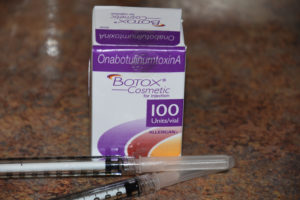Excessive sweating, also known as primary focal hyperhidrosis (PFH), is a disorder of the sweat glands that may involve the axillae, palms of the hands or soles of the feet. Why the sweat glands produce such high volumes of fluid is not known. This problem affects nearly 3% of the US population and is understandably associated with considerable embarrassment issues. There is also the need for frequent clothing changes which poses physical and occupational problems.
Axillary hyperhidrosis has been treated by a variety of strategies including topical aluminum salts, oral anti-sweating agents, numerous surgical approaches that either cut out and try to remove the sweat galnds, and even nerve sympathectomies. These treatments, however, have never been consistently successful and some have a relatively high incidence of adverse effects and complications.

Botox injections are fairly easy to do and relatively painless. Ideally the injection site is first mapped out by the starch test. Iodinated starch power is initially dusted on the surface of the armpit. When this powder contacts sweat, it turns a dark purple which clearly outlines the problem area. While this is the standard approach, I often do not feel that the starch test is absolutely necessary. Most of the excessive sweating areas will come from the hair-bearing part of the armpit. Mapping out the hair zone will usually encompass the sweating zone.
Botox Injections are done with a very small needle and are injected about 1 cm apart which is their approximate diffusion zone. It usually takes about 50 units per armpits or about 12 injections per side. While one could treat just one side to determine dose response, most patients prefer to do both at the same time. Each injection is like a tiny pinprick so it is not particularly uncomfortable. For those concerned about injection pain, the area can first be coated with an anesthetic cream done thirty minutes before the injections.
There usually is little post-injection issues. Sometimes it may be mildly sore for a day or two and an occasional injection bruise may develop. But otherwise one resumes all activities immediately after. It may take up to two weeks after the injections to see the full effect. It is certainly possible that some sweat glands may be missed. These ‘skip’ areas can be re-injected after the two week period when one is certain that they are not the result of a delayed Botox onset.
While Botox is not a permanent cure for axillary hyperhidosis, it can produce some remarkable dryness results that can be life changing. In my Indianapolis plastic surgery practice, I have observed that results can persist for at least six months and may well last longer than a year for many patients.
Dr. Barry Eppley
Indianapolis, Indiana


